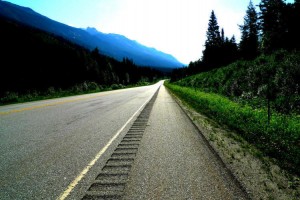Highway 16 east of Tete Jaune Cache.
Project implementation plan
Over the last couple weeks, we held group meetings to discuss our report template. As of now, our report will be divided into the following sections (subject to review and changes):
- 1.0 Introduction
- 2.0 Description and Categorization
- 3.1 Rumble Strips
- 3.2 Road Condition Variables
- 3.0 Analysis of Variables – Disadvantages, Problems, or Benefits
- 3.1 Steepness (Variable 1)
- 3.2 Obstructions and Barriers (Variable 2)
- 3.3 Road Geometry (Variable 3)
- 3.4 Shoulder Width (Variable 4)
- 4.0 Importance of Rumble Strip options for each Variable5.0 Results and Discussion of Exceptions
- 4.1 Steepness (Variable 1)
- 4.2 Obstructions and Barriers (Variable 2)
- 4.3 Road Geometry (Variable 3)
- 4.4 Shoulder Width (Variable 4)
- 6.0 Rumble Strip Code and Standards
- 7.0 Conclusive Summary
As a group, we decided that our research and content of the report can be portrayed by dividing our information into two independent categories: rumble strips and road conditions.
There are many significant differences in rumble strips including: the position of rumble strips, the type of rumble strips, etc. There are also many significant differences in road conditions (variables) including: steepness, obstruction and barriers, and shoulder length.
The purpose of this categorization is so that we can effectively compare the problems, disadvantages, and benefits of each particular road condition to a particular rumble strip type. There is because there is no one best rumble strip design because there are various, significant differences in road conditions.
In the end, we will be input these categories into a matrix and generate different combinations. To find the problems, disadvantages, and benefits of a particular combination, we look to similar real world examples and already implemented rumble strips.
On-site Activities:
Since we don’t have the resources and equipments to conduct surveys of our own, our research will help us investigate the combinations.
Indicators of success:
BCCC could use our report as a reference to affect the current policy for the benefit of cyclists Our report could actually make a difference to the community.
For example: BCCC could use our report as a reference when lobbying or educating the general public.
Task, Completion, and Schedules
The research of the road conditions and rumble strips tasks are assigned this week and expected to be completed by March 12. We will begin writing Sections 2.0, 3.0 and variable 4.0 and complete it by March 19. We will complete the rest of the report and editing by March 26.
Section 2.0–Luke Jason
Section 3.0–Sunny,Tony
Section 4.0–Robin,Michael
Meanwhile, we will work on the poster starting March 13 and finish it by March 25.


Hi Team,
I think you will find that the bicycling public will be very interested in your work. I used to travel by bike almost 100% and am very much looking forward to reading your report (are you able to send me a copy?). The proposed organization of your report, and the framework for your decision making, is solid.
Stepping back from the details of the project, can you identify the similarities and differences between this project and the CIVL 201 project? How does your project compare to other CBEL projects (check out: http://civl202-civil.sites.olt.ubc.ca/community-service-learning-projects/csl-project-blogs-2012/) How might the management of a large civil engineering project compare?
Keep up this fine work.
-SN
The report structure looks very sound and the team appears to have a grasp of the scope of the project as well as defined research goals. I look forward to seeing the report through to fruition.
-Calvin
report template is very professional and looking niece. You are going great, as institute like BBC use your report reference